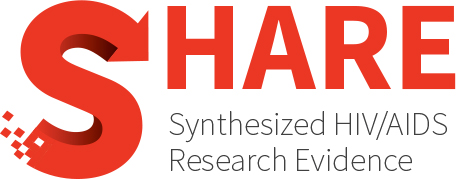Category Archives: Governance arrangements
How decisions about care are made
Health-related quality of life in people with advanced HIV disease, from 1996 to 2021: Systematic review and meta-analysis
The purpose of the study was to assess the effects of advanced HIV disease (AHD) on health-related quality of life (HRQoL) in PLHIV, the changes in HRQoL outcomes over the...
Facilitators and barriers to adherence to anti-retroviral treatment among pregnant or breastfeeding women living with HIV and perinatally infected infants: A scoping review
In 2022, 54% of 1.5 million children (age 0-14) living with HIV had access to anti-retroviral medication (ART). Adherence to ART for pregnant or breastfeeding HIV + women is critical...
Fast-track interventions for HIV and AIDS epidemic control among key populations: A rapid review
BACKGROUND: Targeted interventions for key populations remain critical for realisation of epidemic control for human immunodeficiency virus (HIV) infection because of the causal relationship between HIV infection in the general...
Psychometric properties of stigma and discrimination measurement tools for persons living with HIV: A systematic review using the COSMIN methodology
BACKGROUND: The development of antiretroviral therapy broadly extends the life expectancy of persons living with HIV (PLHIV). However, stigma and discrimination are still great threat to these individuals and the...
HIV associated neurocognitive disorder screening and diagnosis pathways in Australia: A scoping review and international implications
Symptomatic HIV-associated neurocognitive disorder (HAND) is a complication of HIV (cognitive impairment, difficulties with everyday functioning). If detected early, interventions assist with optimizing care, avoiding rapid decline and enhancing coping....
A contextualization of transgender women and condom use using the HIV syndemic framework: Scoping review
Objective: To contextualize condom use in the transgender women population utilizing the HIV syndemic framework. Methods: Studies reporting condom use frequency and syndemic factors associated with HIV risk in transgender...
A community guide systematic review: Digital HIV pre-exposure prophylaxis interventions
INTRODUCTION: HIV preexposure prophylaxis (PrEP) is highly effective when taken as prescribed. Digital health adherence interventions have been identified as effective for improving antiretroviral therapy adherence among people with HIV,...
Providing anti-retroviral treatment did not achieve the ambition of ‘Joint united nations program on HIV/AIDS (UNAIDS) among HIV positive patient in Ethiopia’: A systematic review and meta-analysis
INTRODUCTION: Antiretroviral Treatment (ART) has great importance in reducing viral load. Though a global effort was made to suppress viral load, the level of viral load suppression among ART patients...
Hiding in plain sight: Highlighting the research gap on access to HIV and other sexual health services for underrepresented gay men in developed Western countries—Insights from a scoping review with a focus on Arab men
BACKGROUND: Strategies pertaining to HIV and sexual health for gay, bisexual, and other men who have sex with men (GBMSM) have shifted focus towards underrepresented subgroups within some developed Western...
Country ownership and sustainable programming of the HIV response in South Africa: A scoping review
BACKGROUND: Concerns have arisen regarding the extent to which South Africa’s HIV response can be country-owned and sustainable given substantial foreign investment and technical support. OBJECTIVES: To assess the extent...
Exploring implementation considerations for geriatric-HIV clinics: A secondary analysis from a scoping review on HIV models of geriatric care
OBJECTIVES: This review aimed to map the current state of knowledge regarding the implementation considerations of existing geriatric-HIV models of care, to identify areas of further research and to inform...
HIV pre-exposure prophylaxis, blood donor deferral, occult infection, and risk of HIV transmission by transfusion: A fine balance between evidence-based donor selection criteria and transfusion safety
Pre- and postexposure prophylaxis for human immunodeficiency virus (HIV) are key to reducing the transmission of this virus. Furthermore, low-toxicity, long-acting formulations provide additional clinical benefits, in particular easier adherence...
